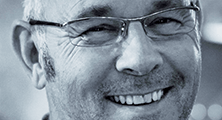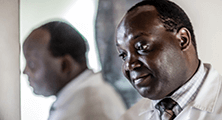
The VISION 2020 LINKS program is a collaboration between hospitals in the United Kingdom and across Africa to share training, equipment and experience. Administered by the International Centre for Eye Health (ICEH) under the VISION 2020 umbrella, the LINKS program helps African clinics identify their priority needs, matches them with a partner hospital in the UK, and then supports that link with management, funding and training visits between the two institutions. With this program, we hope to alleviate the shortage of trained eye health workers in Africa and improve eye services across the continent. As part of the link between the Royal Free Hospital in London and Mulago National Referral Hospital in Kampala, Uganda, several of us recently traveled there to introduce some new eye health programs, deliver equipment, and raise awareness of our mission both locally and globally.
When we arrived in Entebbe, we were picked up by a minibus from the hospital – which was quite a memorable trip, because Ugandan roads aren’t great. We had a saying about them: they don’t have speed bumps, they have speed holes. But they don’t seem to stop the taxi drivers from going very fast. Not that we used taxis very often; our usual form of transport, because it was extremely inexpensive, was motorbikes called “boda boda.” Basically, you ride on the back as a pillion passenger – without a helmet, of course – which can be quite interesting on the rough roads, especially as they go pretty quickly even over the speed bumps. Geoff Woodruff, our consultant pediatric ophthalmologist, was a little bit concerned about them, though; he told us, “If you want to find out how poor neurosurgery is in Uganda, try falling off one of those.”
We had wanted to stay in the hospital accommodations, so that we could be close to the doctors and staff there. Unfortunately, some medical students from Canada had got there first! We ended up staying in a small local hotel nearby and walking to the clinic each morning – which was another interesting experience. Each morning, we’d brave the crossing and spend the day working in the ophthalmology department. One day, we examined a 58-year-old gentleman called Charles Ndegeya who had severe diabetic retinopathy (DR). We were able to diagnose the problem and then treat him by laser – but his story actually made the national news, because he was the first person in Uganda to have an optical coherence tomography (OCT) exam.
That “first” is a source of great pride for us, because our mission was to introduce diabetic retinal screening in Uganda. We went to Kampala for 10 days to do as much screening as possible, and to reinforce the hospital – their staff’s understanding of grading, the ability to attract patients, and the logistics of implementing widespread screening. We also treated patients with DR; fortunately, the hospital has a laser (and will hopefully be getting bevacizumab next year as well), so we weren’t trapped in the position of being able to diagnose but lacking a way to treat the disease. That was the first arm of the mission, but it wasn’t our only purpose; we also brought along Geoff Woodruff to introduce a leukocoria project. His goal was to teach parents to have their children seen urgently if they noticed a white pupil or other abnormality – as well as to treat the children who were brought in, of course, and training hospital staff in pediatric IOL implantation. Congenital cataract and retinoblastoma are common problems in Uganda, and we needed to encourage parents to bring their children for testing, and educate hospital staff in how to treat those problems.
Both arms of the mission received a lot of support. Thanks to charitable donations from companies like Volk and Rayner, we were able to take with us some portable fundus cameras and the first OCT instrument in the country, as well as a lot of instruments and IOLs – particularly pediatric IOLs. We’re enthusiastic about the equipment, and we hope that what we learn in Africa might one day have benefits beyond those borders. Health inequality exists everywhere, and low-cost or portable equipment might be able to plug some of those gaps even in developed countries. We also noticed that, with portable equipment, there seems to be less of a “fear factor.” The ability to sit a patient in a chair and approach them, rather than saying, “Come and sit at this thing, hold onto these bars, and put your head in here,” really helps. We saw a lot of patients who were hesitant to work with us – it’s bad enough having dilating drops that sting their eyes, but then asking them to approach a somewhat frightening bit of equipment can be too much. So we were glad from both a cost and a patient perspective that we had smaller, less expensive instruments.
The next step is to introduce leadership development, which we’re planning to do on our Uganda trips in 2016. One aspect of that is training our colleagues there in skills that will help them develop the hospital’s ophthalmology department. This time around, they received initial training in DR screening – but in the future, they’ll also need to learn how to keep the equipment running (a current challenge in Kampala), and how to pass on their knowledge to others. On the pediatric glaucoma side, one of the consultant ophthalmologists in Kampala continues to be trained in implanting pediatric IOLs, which is the key to reducing the impact of pediatric cataracts. The other part of leadership development is service improvement. In DR screening, for example, that means not only setting up the program, but putting measures in place to track the number of patients screened, the number treated, success rates, and so on. Ultimately, we want to take what’s being done in Kampala and roll it out across Uganda. Kampala is somewhat of a nucleus at the moment, but in the future, we hope the local medical staff will be able to go to other hospitals and introduce these programs themselves. The most important aspect of these links isn’t going out to Africa and doing things; it’s about going out there and teaching, so that they can do things for themselves.
It’s important to emphasize, though, that the VISION 2020 LINKS program isn’t a one-way street. It’s very much a reciprocal arrangement; teams from the UK go out to Uganda, but on a regular basis, medical and nursing staff from Uganda also come to the UK. Just last weekend, four nurses stayed with us for a couple of weeks for training in diabetic screening and pediatric ophthalmology. And they teach us a lot – at the Royal Free Hospital in London, for instance, we’ve noticed a lot more cohesiveness in the ophthalmology department. We always go to Uganda with an orthoptist and a nurse, and we see the other nurses supporting the one who’s traveling; we see the other orthoptists supporting the one who’s traveling. It breaks down barriers between people at the hospital, and between us and our patients as well. A lot of our patients weren’t born in the United Kingdom, and putting ourselves in a position where we were the minority made a difference – it helped us to see things from that perspective. The other benefit is that, even after they’ve returned, people who’ve been on one of these trips tend to think on their feet. That’s what the Africans do, and that’s what we carry back with us – that if there isn’t a convenient solution, we think, “Actually, it’s up to me to find one.” And those things – the trust, friendship and independence we develop by learning from one another – are the reason we participate in the LINKS program. It’s rewarding in many, many ways.
I work as an ophthalmologist in the Mulago National Referral Hospital eye department, which has benefited immensely from a link with Royal Free Hospital in London. Thanks to that link, we have increased subspecialty training, more equipment, and improved the quality of care for our patients.
I’m the coordinator on the Royal Free Hospital side of the Vison 2020 LINKS program to improve eye care in Kampala, Uganda. Our recent mission was part of the DRCR.net push to introduce diabetic retinal screening in Uganda, funded by the Queen Elizabeth Diamond Jubilee Trust.
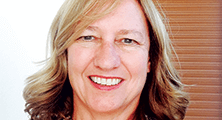
I run the Vision 2020 LINKS program based at the International Centre for Eye Health (ICEH). We match institutions in Africa with a partner in the UK so that they can work together on priority areas for improving eye care.
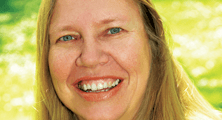
I co-direct the ICEH. I’m an ophthalmologist trained in epidemiology, and my main role is managing the research side of what we do – but I also have input into our Masters program, advisory committees for the LINKS program, and various external advisory roles to international organizations.
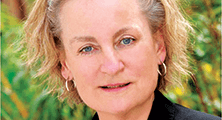
I’m one of the registrars at the Royal Free Hospital. I was privileged to join a recent mission and help train Ugandan doctors and medical students in the use of the first optical coherence tomography (OCT) equipment in the country.
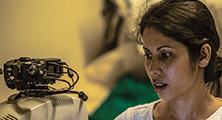
My role in the mission was to provide portable fundus cameras, but also to take photographs along the way with a view to publicizing the activity of the charity. I also worked in media relations, making contact with the national media in Uganda to raise awareness of our work.
